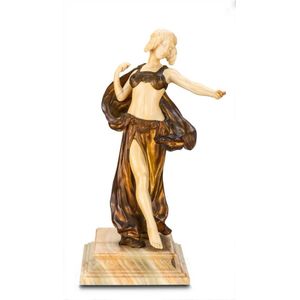Austrian Art Nouveau Porcelain Statue, 1900
You must be a subscriber, and be logged in to view price and dealer details.
Subscribe Now to view actual auction price for this item
When you subscribe, you have the option of setting the currency in which to display prices to $Au, $US, $NZ or Stg.
- Art Nouveau Period - The Art Nouveau period was a cultural movement that emerged in the late 19th century, and was characterized by its emphasis on natural forms, flowing lines, and a decorative, ornamental style. Art Nouveau was a reaction against the ornate and heavily stylized designs of the previous era, and sought to create a new, more organic aesthetic.
Art Nouveau was characterized by its use of sinuous, curving lines, as well as a focus on natural elements such as flowers, vines, and other organic shapes. Art Nouveau designers sought to create a total work of art, in which every element of a building or object was designed to be harmonious with the overall design.
Some of the most iconic examples of Art Nouveau design include the Paris Metro entrances designed by Hector Guimard, the works of the artist Alphonse Mucha, and the architecture of Victor Horta in Brussels.
The Art Nouveau period was at its peak between 1890 and 1910, but began to decline in popularity by the start of World War I. However, Art Nouveau remains an important influence on design and art to this day, and continues to be celebrated for its emphasis on natural forms and decorative style. - Imperial Amphora - Imperial Amphora was a brand of ceramics that was produced by the Amphora Pottery Company, which was a Czechoslovakian company that was active in the early 20th century. The Amphora Pottery Company was founded in the town of Turn-Teplitz (now called Teplice), which was a centre of the Czechoslovakian ceramics industry at the time. Imperial Amphora ceramics were known for their high quality and attention to detail, and were highly prized by collectors. The company produced a wide range of ceramic products, including vases, figurines, and decorative objects. Many of the company's products were made in the Art Nouveau style, which was popular in the early 20th century, and were decorated with intricate, stylized designs. The Amphora Pottery Company was nationalized by the Czech government in the 1940s and was eventually absorbed into a larger state-owned ceramics company.
- Circa - A Latin term meaning 'about', often used in the antique trade to give an approximate date for the piece, usually considered to be five years on either side of the circa year. Thus, circa 1900 means the piece was made about 1900, probably between 1895 and 1905. The expression is sometimes abbreviated to c.1900.
This item has been included into following indexes:
Visually similar items

A patinated bronze and ivory figure by Louis Sosson, French, circa 1920. 35 cm high

An interesting hand carved polychrome painted rocking horse

A 1930's spelter bronze figure of a footballer. The athlete stands poised to throw the ball in. Raised on a black variegated marble plinth. Indistinct signature to base. Height 66 cm.

An Italian carved marble figure of flora, with two baskets of flowers, height 155 cm
